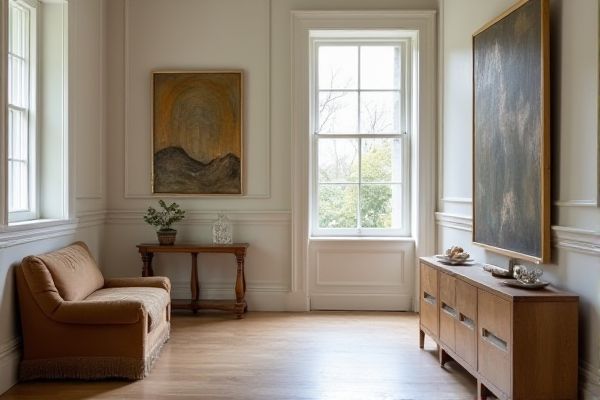
Narrow consoles maximize space efficiency and fit well in tight areas, while wide consoles offer more surface area for decor and storage, enhancing room functionality. Explore the rest of the article to discover which console style best suits your space and lifestyle needs.
Table of Comparison
| Feature | Narrow Console | Wide Console |
|---|---|---|
| Width | Less than 18 inches | 18 inches or more |
| Space Efficiency | Ideal for small spaces | Requires more room |
| Storage | Limited storage options | Offers multiple storage compartments |
| Functionality | Basic functions, minimal controls | Advanced controls, multitasking capabilities |
| Usage | Best for casual use or tight setups | Suited for professional or intensive use |
| Design | Compact and sleek | Robust and spacious |
Introduction to Narrow vs Wide Consoles
Narrow consoles typically measure between 24 to 36 inches in width, designed to fit tight spaces or hallways while providing essential storage and display options. Wide consoles, often exceeding 48 inches, offer expansive surfaces ideal for larger rooms, accommodating multiple decorative items or media equipment. Choosing between narrow and wide consoles depends on spatial constraints, functional needs, and aesthetic preferences for interior design.
Key Differences Between Narrow and Wide Consoles
Narrow consoles typically measure between 12 to 24 inches in width, making them ideal for tight spaces and minimalist decor. Wide consoles range from 48 to 72 inches, offering more surface area for decorative items, storage, or media equipment. Your choice depends on available space and the functional needs of the room, ensuring optimal balance between style and utility.
Aesthetic Impact on Interior Design
Narrow consoles create a sleek, minimalist look that enhances spaciousness in smaller rooms, making them ideal for tight entryways or hallways. Wide consoles offer a bold, statement-making presence, anchoring larger spaces with ample surface area for decorative elements and storage. Choosing between narrow and wide consoles significantly influences the balance, proportion, and visual flow of interior design schemes.
Space Considerations: Which Fits Better?
Narrow consoles are ideal for small or tight spaces, providing ample surface area without overwhelming the room, making them perfect for entryways or narrow hallways. Wide consoles offer more storage and display area but require larger wall space, fitting well in spacious living rooms or wide corridors. Choosing between a narrow or wide console depends on the available floor space and the need for balance between functionality and room flow.
Storage and Functionality Comparison
Narrow consoles offer compact storage solutions with limited shelf space and smaller drawers, ideal for tight areas but less efficient for extensive organization. Wide consoles provide expansive storage capacity, featuring larger compartments and multiple drawers that enhance functionality for diverse items and electronics. The choice depends on space availability and storage needs, with wide consoles excelling in versatility and narrow consoles optimizing minimal footprints.
Material and Style Options
Narrow consoles typically feature sleek materials such as metal and glass, emphasizing minimalist and modern styles that save space without sacrificing elegance. Wide consoles offer a broader selection of materials including solid wood, marble, and engineered composites, catering to diverse styles from rustic farmhouse to luxurious contemporary. Material choices for wide consoles allow for more intricate designs, textures, and finishes, making them versatile centerpieces in larger rooms.
Ideal Rooms for Narrow Consoles
Narrow consoles are ideal for small or tight spaces such as entryways, hallways, or apartments where floor space is limited. Their slim design maximizes functionality without overwhelming the room, making them perfect for adding storage or display surfaces in compact areas. You can enhance narrow bedrooms or living rooms by choosing a console that fits seamlessly against a wall, maintaining an open, uncluttered feel.
Best Uses for Wide Consoles
Wide consoles excel in spacious living rooms or entryways, providing ample surface area for decorative items, media equipment, or storage solutions. They accommodate multiple functions, such as housing a television, displaying books, or organizing keys and mail, enhancing both aesthetics and practicality. Your choice of a wide console ensures a balanced proportion in expansive spaces, creating a stylish and functional focal point.
Pros and Cons: Narrow Console vs Wide Console
Narrow consoles save space and fit well in tight areas, offering a sleek, minimalist look but often sacrifice storage capacity and surface area. Wide consoles provide ample storage and display space, enhancing functionality for entertainment setups but require more room and can overwhelm smaller spaces. Choosing between narrow and wide consoles depends on balancing spatial constraints with the need for storage and surface utility.
How to Choose the Right Console for Your Space
Choosing the right console for your space depends on available room dimensions and intended function; narrow consoles maximize space efficiency in tight areas, ideal for hallways or small entryways, while wide consoles offer more surface area for decor and storage in larger rooms. Consider the depth and height to ensure comfortable use without overcrowding your layout. Your selection should balance style with practical needs, ensuring the console complements your room's flow and enhances overall usability.
 homyna.com
homyna.com